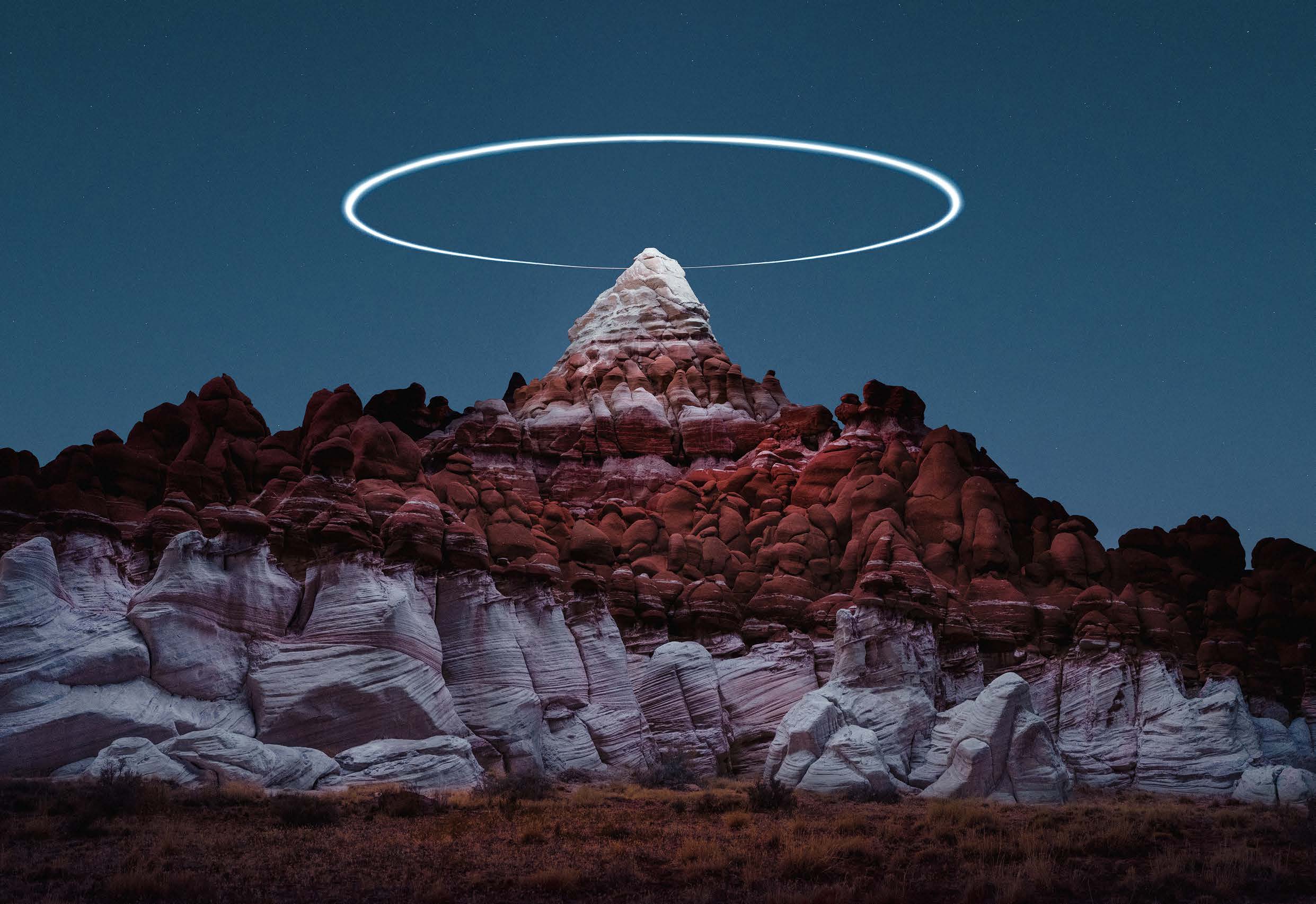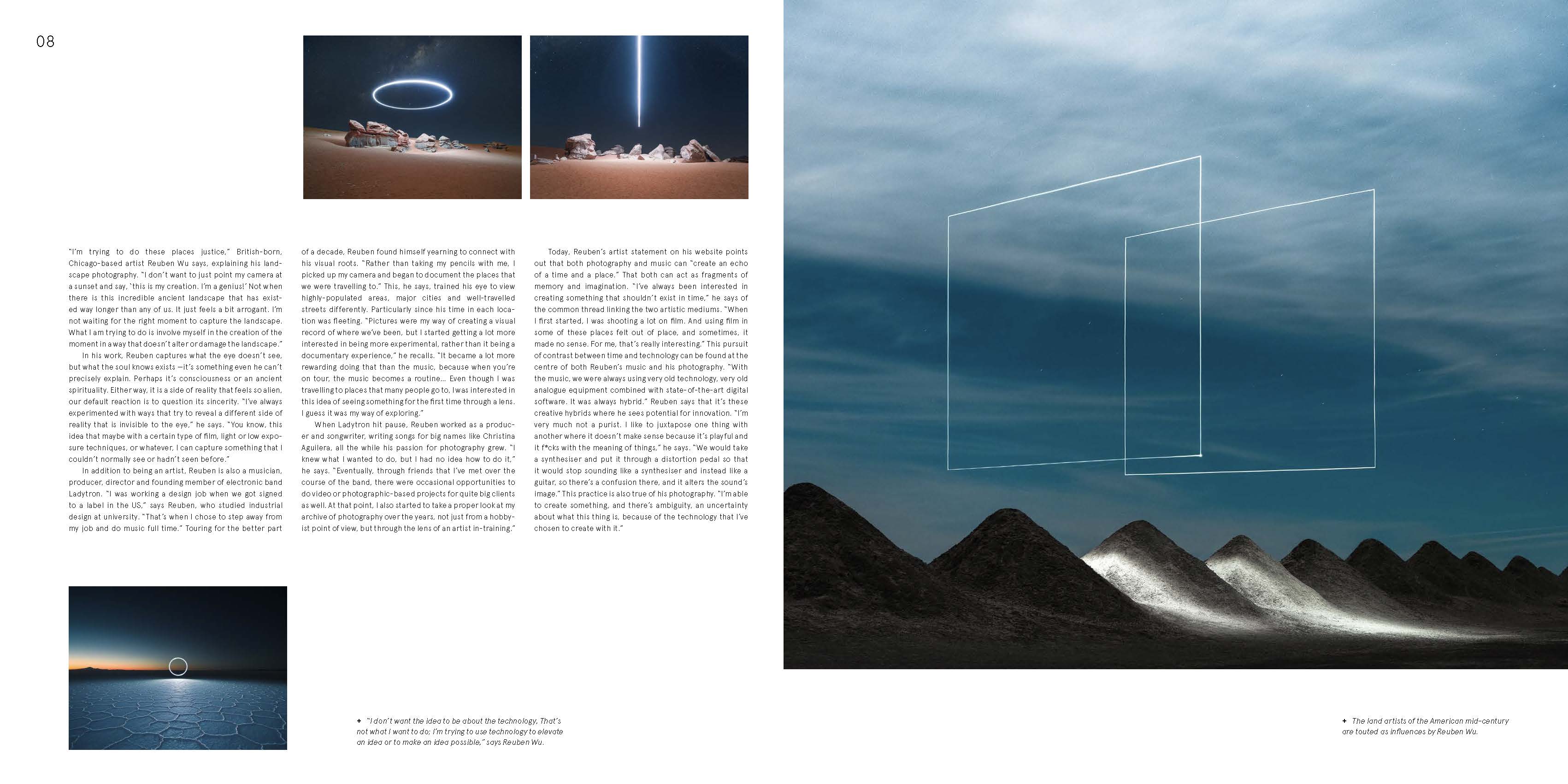Skies of Wonder: Reuben WU
“I’m trying to do these places justice,” British-born, Chicago-based artist Reuben Wu says, explaining his land- scape photography. “I don’t want to just point my camera at a sunset and say, ‘this is my creation. I’m a genius!’ Not when there is this incredible ancient landscape that has exist- ed way longer than any of us. It just feels a bit arrogant. I’m not waiting for the right moment to capture the landscape. What I am trying to do is involve myself in the creation of the moment in a way that doesn’t alter or damage the landscape.” In his work, Reuben captures what the eye doesn’t see, but what the soul knows exists —it’s something even he can’t precisely explain. Perhaps it’s consciousness or an ancient spirituality. Either way, it is a side of reality that feels so alien, our default reaction is to question its sincerity. “I’ve always experimented with ways that try to reveal a different side of reality that is invisible to the eye,” he says. “You know, this idea that maybe with a certain type of film, light or low expo- sure techniques, or whatever, I can capture something that I couldn’t normally see or hadn’t seen before.”
In addition to being an artist, Reuben is also a musician, producer, director and founding member of electronic band Ladytron. “I was working a design job when we got signed to a label in the US,” says Reuben, who studied industrial design at university. “That’s when I chose to step away from my job and do music full time.” Touring for the better part of a decade, Reuben found himself yearning to connect with his visual roots. “Rather than taking my pencils with me, I picked up my camera and began to document the places that we were travelling to.” This, he says, trained his eye to view highly-populated areas, major cities and well-travelled streets differently. Particularly since his time in each loca- tion was fleeting. “Pictures were my way of creating a visual record of where we’ve been, but I started getting a lot more interested in being more experimental, rather than it being a documentary experience,” he recalls. “It became a lot more rewarding doing that than the music, because when you’re on tour, the music becomes a routine… Even though I was travelling to places that many people go to, I was interested in this idea of seeing something for the first time through a lens. I guess it was my way of exploring.”
When Ladytron hit pause, Reuben worked as a producer and songwriter, writing songs for big names like Christina Aguilera, all the while his passion for photography grew. “I knew what I wanted to do, but I had no idea how to do it,” he says. “Eventually, through friends that I’ve met over the course of the band, there were occasional opportunities to do video or photographic-based projects for quite big clients as well. At that point, I also started to take a proper look at my archive of photography over the years, not just from a hobby- ist point of view, but through the lens of an artist in-training.”
Today, Reuben’s artist statement on his website points out that both photography and music can “create an echo of a time and a place.” That both can act as fragments of memory and imagination. “I’ve always been interested in creating something that shouldn’t exist in time,” he says of the common thread linking the two artistic mediums. “When I first started, I was shooting a lot on film. And using film in some of these places felt out of place, and sometimes, it made no sense. For me, that’s really interesting.” This pursuit of contrast between time and technology can be found at the centre of both Reuben’s music and his photography. “With the music, we were always using very old technology, very old analogue equipment combined with state-of-the-art digital software. It was always hybrid.” Reuben says that it’s these creative hybrids where he sees potential for innovation. “I’m very much not a purist. I like to juxtapose one thing with another where it doesn’t make sense because it’s playful and it f*cks with the meaning of things,” he says. “We would take a synthesiser and put it through a distortion pedal so that it would stop sounding like a synthesiser and instead like a guitar, so there’s a confusion there, and it alters the sound’s image.” This practice is also true of his photography. “I’m able to create something, and there’s ambiguity, an uncertainty about what this thing is, because of the technology that I’ve chosen to create with it.”
The series you see here, ‘Lux Noctis’ and ‘Field of Infinity’, are inspired by time, space, planetary explo- ration, science fiction and romanticism; and draw upon influences that include Close Encounters of the Third Kind, David Lynch and the work of Gregory Crewdson. In these works, Reuben has used drone technology to carve out light patterns above earthly landscapes. Much of Reuben’s work is inspired by the Land Art movement of the ’60s, but unlike that practice, which would often alter or damage the landscape, his lines of light leave no trace. “I don’t want the idea to be about the technol- ogy,” he says. “That’s not what I want to do; I’m trying to use technology to elevate an idea or to make an idea possible.” The challenge, he points out, is to bring Land Art into the future, but in a way that the technology stays invisible. “Instead of using the drone to take pictures, I’m using the drone as a light source itself, which I can control remotely. For me, that’s almost like a latter-day Land Art movement because now I’m able to create these visible forms around the landscape without touching it, which is great in really fragile places. That is so valuable to me.” As pop culture increasingly fetishises space, alien worlds, and our place among them, Reuben’s photo- graphs are a reminder of the ethereal corners found right here on earth. “I’m always looking at ways to make people look harder and ask, ‘What is this place? Is it real? Is it fake? Is it a rendering? Or is it a photo? I really enjoy blur- ring the meaning and creating an ambiguity of an image.” Many of these landscapes are familiar tourist spots, and yet Reuben shifts their existence into the speculative. “Maybe this is a place which has been seen millions of times, but what I’m trying to do is reveal something new for eyes that are maybe tired of seeing so much.”



